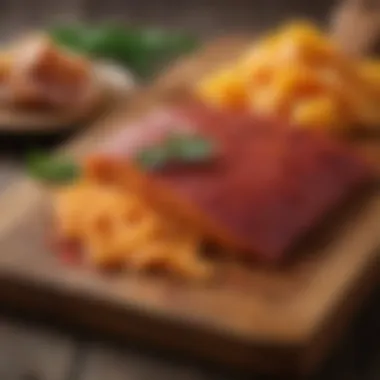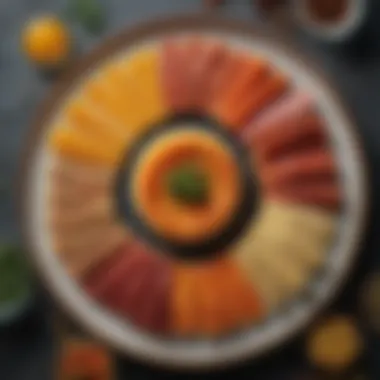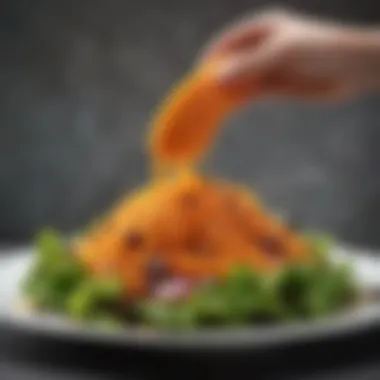Bottarga at Whole Foods: A Culinary Exploration


Intro
The exploration of culinary ingredients can lead to exciting discoveries. One ingredient that stands out in both flavor and uniqueness is bottarga. A delicacy originating from the Mediterranean, bottarga involves the curing of fish roe, typically from the gray mullet or tuna. In recent years, it has emerged in contemporary kitchens, drawing attention in gourmet settings and home cooking. Whole Foods, known for its diverse and high-quality food selection, offers bottarga, making it more accessible to culinary enthusiasts.
This culinary exploration will take you through various facets of bottarga—from its origins to its culinary applications, as well as the health benefits it offers. Understanding these aspects will not only enhance your knowledge but also enrich your cooking repertoire with this exquisite ingredient.
Understanding Bottarga
Bottarga is an intriguing ingredient that often captures the attention of culinary enthusiasts. Understanding what bottarga is and the nuances surrounding it can greatly enhance one's culinary journey. This section serves to illuminate the deeper aspects of bottarga, including its definition, historical context, and its unique role in various cuisines.
Definition and Origins
Bottarga refers to the salted, cured roe of fish, commonly grey mullet or tuna. It is produced through an intricate process, which involves careful selection of fish, salting, drying, and aging. The end product resembles a hard block or a thin sheet, often grated or sliced to enhance dishes. The origins of bottarga trace back to Mediterranean countries, particularly Italy and Tunisia, where it has been a staple for centuries. Historically, it was a means of preserving fish roe, ensuring that it could be enjoyed long after the fishing season. The methods of preparation may vary slightly across regions, but the fundamental elements remain consistent, speaking to its time-honored roots.
Cultural Significance
Bottarga holds significant cultural importance in several Mediterranean cuisines. Its use aligns with the tradition of maximizing the utility of the catch, embodying sustainability by ensuring minimal waste. In Italian cuisine, for instance, bottarga is often used in pasta dishes, highlighting its ability to elevate otherwise simple ingredients. The cultural nuances extend to its reception, as bottarga is regarded as a delicacy, often associated with luxury dining and high culinary artistry. In Tunisia, it also ties into ceremonial and festive meals, showcasing the ingredient's versatility across different cultural contexts. This rich heritage not only informs its culinary applications but also enhances its appreciation among food lovers.
Bottarga is more than just an ingredient; it is a bridge connecting generations of culinary tradition and innovation.
Understanding bottarga opens the door to exploring its potential in modern culinary practices, making it a worthy addition to the repertoire of any food lover.
The Process of Making Bottarga
The production of bottarga is a meticulous process that plays a crucial role in defining its unique taste and texture. Understanding the steps involved in its creation enhances one's appreciation of this delicacy. Each phase offers insights into the traditions of preserving fish, contributing to both flavor and nutrition. This process is not only about skill; it is also a testament to centuries of culinary heritage and environmental awareness.
Selection of Fish
The first step in making bottarga is the selection of fish. Traditionally, mullet and tuna are the preferred species, as their roe provides a rich, flavorful product. The quality of the fish significantly impacts the final outcome. Freshness is paramount because older fish can introduce undesirable flavors. Fish caught in certain seasons may also yield better-quality roe. Smaller, younger fish tend to have a more delicate taste, while larger ones may offer a more robust flavor. This selection must align with sustainability practices, ensuring that the fish used is sourced responsibly.
Salting and Drying
Once the fish is selected, the next phase involves salting and drying. The roe sacs are carefully extracted and lavished with coarse sea salt. This salting helps in preserving the sac and also intensifies the flavor. The process typically lasts several days, allowing the salt to penetrate deeply. After salting, the roe is then allowed to dry, either in the sun or under controlled conditions. The drying process is crucial, as it helps develop the firm texture characteristic of bottarga while concentrating the flavors. Quality control is essential at this stage, as too much moisture can spoil the end product.
Aging Techniques
Aging is another important step that further develops bottarga's complex flavors. Once dried, the bottarga can be aged for various lengths of time, depending on desired taste profile. Shorter aging can impart a fresh, briny savor, whereas longer aging might yield a more intense umami quality. Traditionally, bottarga is kept in a cool, dark place. Some producers wrap it in cloth or store it in oil to protect it from air exposure. This aging phase is essential, as it can drastically affect the aroma and depth of flavor.
The art of making bottarga is steeped in tradition, yet it evolves with modern techniques that respect both flavor and sustainability.
Bottarga in the Market
Understanding the availability and quality of bottarga within the market context is essential for appreciating its culinary value. Bottarga, which is a cured fish roe, has gained popularity among food enthusiasts. In markets like Whole Foods, its presence reflects growing interest in gourmet ingredients, particularly those that offer unique flavors and nutritional benefits.


Availability at Whole Foods
Whole Foods serves as a key retailer where consumers can find bottarga. Its aisles feature not just standard ingredients but also artisanal and specialty items. This retailer sources bottarga from reputable suppliers. Typically, one can find bottarga made from mullet or tuna. The product is usually displayed near other seafood products or gourmet ingredients, allowing consumers to make informed choices.
Finding bottarga at Whole Foods often comes with the benefit of freshness and quality assurance. The fish roe is generally packaged properly to ensure it retains its flavor and aroma. Customers may see different forms of bottarga available, from slices to grated options. The pricing can vary based on the type of fish used and the curing process.
When purchasing bottarga at Whole Foods, consumers should look for labeling that indicates its origin and curing methods. Local sourcing is also a significant aspect, as many consumers prefer products that support sustainable fishing practices.
Comparing Quality and Types
When exploring bottarga, quality and types play a significant role. The two main varieties are bottarga di muggine (mullet) and bottarga di tonno (tuna). Each type offers distinct flavors and textures, appealing to various culinary applications.
Quality indicators for bottarga include:
- Color: Look for a rich, golden hue, which indicates good quality.
- Texture: High-quality bottarga should be firm to the touch but not dry.
- Aroma: A fresh, clean scent is a positive sign; avoid any fishy odors.
When comparing these two types, bottarga di muggine is milder and often preferred in Mediterranean dishes, while bottarga di tonno presents a more robust flavor. Consumers should also consider the curing process, as traditional methods tend to yield superior taste and quality.
In summary, purchasing bottarga at Whole Foods allows access to quality products and aligns with food trends towards more sustainable options. Consumers should take the time to examine different types and qualities, as this enhances their culinary experience.
Nutritional Profile of Bottarga
Understanding the nutritional profile of bottarga is crucial for those looking to incorporate this unique ingredient into their diets. Bottarga is not only a delicacy but also offers a variety of nutrients that can enhance overall health. It is worth noting that as more consumers seek healthier food options, knowing the strengths of bottarga can lead to a deeper appreciation for its culinary uses.
Rich Source of Nutrients
Bottarga, often referred to as "cured fish roe," packs a significant nutrient punch. It is primarily made from the eggs of mullet or tuna, which are salted and dried, preserving their nutritional content. Here are key nutrients found in bottarga:
- Omega-3 Fatty Acids: Essential for heart health, omega-3 fatty acids help reduce inflammation and lower the risk of chronic diseases.
- Protein: Bottarga is rich in protein, which is vital for muscle repair and growth.
- Vitamins B12 and D: Vitamin B12 is crucial for nerve function, while vitamin D aids in calcium absorption and bone health.
Additionally, bottarga provides several minerals, including selenium and phosphorus. Selenium, an antioxidant, contributes to a healthy immune system. Phosphorus plays a role in maintaining energy levels in the body. This combination makes bottarga an excellent addition to a balanced diet.
Potential Health Benefits
Consuming bottarga can lead to various health benefits, particularly due to its rich nutrient content. Below are some potential advantages of including bottarga in meals:
- Heart Health: Thanks to its high omega-3 fatty acid content, bottarga can help maintain cardiovascular health. Studies suggest that omega-3s can lower blood pressure and triglycerides.
- Enhanced Brain Function: Omega-3s also contribute to brain health, potentially aiding cognitive function and reducing the risk of mental decline as one ages.
- Bone Strength: The combination of vitamins D and phosphorus in bottarga supports bone health, making it a good choice for those who want to strengthen their skeletal system.
Including nutrient-dense ingredients like bottarga in meals can contribute significantly to overall health and well-being.
Culinary Uses of Bottarga
Bottarga plays a significant role in contemporary gastronomy, transforming ordinary dishes into unique culinary experiences. Its delicate yet robust flavor profile acts as a bridge between simplicity and sophistication in cooking. Utilizing bottarga not only enhances taste but also contributes depth to various meals. Understanding its culinary applications can empower food enthusiasts to experiment and elevate their cooking skills.


Flavor Enhancer in Dishes
Bottarga serves as a flavor enhancer that can be applied across various types of cuisine. When grated or sliced thin, it releases a unique umami essence. This characteristic makes it a standout ingredient in many dishes. Common uses include pasta, where bottarga can be sprinkled on finished dishes like spaghetti or linguine to elevate the experience.
Some dishes that benefit from bottarga include:
- Pasta: It pairs beautifully with olive oil and garlic or can add depth to rich cream sauces.
- Seafood: Sprinkling bottarga over grilled fish or seafood salads amplifies their freshness.
- Vegetables: Roasted or sautéed vegetables gain an interesting flavor when complemented by bottarga.
- Soups: A dash of bottarga can enhance the flavor of broths, delivering a subtle saltiness that rounds out the dish.
Bottarga's versatility means it can be reimagined in numerous ways, allowing chef's creativity to shine. Some may explore using it in more unusual applications, such as in dressings or dips, always maintaining its essential character in flavor enhancement.
Pairing Ingredients
Pairing ingredients with bottarga expands its culinary possibilities. The right combinations can heighten its flavors and create harmonious dishes. Familiarity with suitable pairings allows home cooks to innovate while maintaining balance in the meals they prepare.
When considering what to pair with bottarga, various factors come into play:
- Acidity: Ingredients like lemon, capers, or vinegar can offset the richness of bottarga, bringing freshness to the dish.
- Fats: Olive oil and butter can enhance the delivery of flavor from bottarga, especially when infused or served together.
- Herbs: Fresh herbs like parsley and arugula provide a vibrant contrast, complementing bottarga’s salty profile.
- Grains and Legumes: Risottos or farro yield delicious textures and flavors when bottarga is introduced, adding an earthy undertone.
These pairing principles can influence culinary choices, ensuring the harmony of flavors, thereby expanding the horizon of how bottarga can be incorporated into traditional and innovative dishes.
Recipes Featuring Bottarga
Incorporating bottarga into your cooking offers a unique opportunity to elevate various dishes. Its intense umami flavor can enhance simple plates to something extraordinary. Bottarga is not just an ingredient; it is a culinary tool that challenges the palate and encourages creative expression in modern gastronomy. When considering recipes featuring bottarga, one must pay attention to ingredient pairings and preparation techniques. This ensures that bottarga shines without overpowering other flavors. Clear understanding of how to utilize this ingredient effectively will allow for maximized enjoyment and satisfaction.
Simple Pasta Dishes
Pasta serves as an excellent canvas for bottarga. The fat in the pasta helps dissolve the flavor compounds in the bottarga, creating a harmonious dish. For a simple yet satisfying preparation, consider preparing spaghetti aglio e olio with a generous sprinkle of grated bottarga at the finish. The garlic and olive oil provide a rich base while allowing the bottarga to provide a punch of salinity.
Another option involves making a bucatini cacio e pepe. Here, the creamy texture of Pecorino Romano and the fresh cracked pepper can blend beautifully with the bottarga. The combination enhances the overall flavor profile, making the dish a standout without demanding intricate techniques.
Innovative Appetizers
Bottarga can shine prominently in appetizers. It boasts versatility, combining well with various flavors and textures. One appealing appetizer idea includes bottarga-topped crostini. Simply toast slices of country bread and spread a light layer of ricotta. A finishing touch of grated bottarga amplifies the flavors, introducing a savory richness that guests will appreciate.
Another innovative approach is creating a bottarga-infused dip. Blend chickpeas, tahini, lemon juice, and garlic. After mixing, fold in finely grated bottarga for depth and an unexpected twist. Serve this with freshly cut vegetables or pita chips. This dish highlights the unique flavor of bottarga while remaining approachable for many audiences.
Entrees and Main Courses
When transitioning to entrees, bottarga can serve as the key component in seafood dishes. Grilled fish, such as branzino or salmon, can be enhanced with a finishing touch of bottarga. A light drizzle of olive oil mixed with lemon juice along with a sprinkle of bottarga creates a flavorful note that harmonizes well with the fish’s inherent taste.
Another compelling dish is a risotto with bottarga. Using a seafood broth, prepare the risotto until creamy, then fold in grated bottarga just before serving. This infuses the dish with a distinct sea flavor, providing an unforgettable dining experience. Each spoonful will reflect the richness of bottarga, blending seamlessly with the textures of rice.
In closing, the application of bottarga in these recipes demonstrates its adaptability and capacity to enhance flavor. As you explore these culinary ideas, understanding the profile of bottarga will help you navigate its integration into your dishes successfully. Embracing such creative recipes provides not only nourishment but also the joy of exploration in cooking.


Preservation and Storage
Understanding how to preserve and store bottarga is crucial for retaining its flavor and nutritional value. Proper preservation techniques not only maintain the quality of this unique ingredient, but they also ensure its longevity. Bottarga, when inadequately stored, can lose its rich taste and aromatic profile. The aim is to extend its usability for culinary applications, especially for those amateurs or professionals exploring contemporary cooking.
Proper Storage Techniques
To ensure the best storage conditions for your bottarga, follow these guidelines:
- Keep it Cool: Store bottarga in the refrigerator. A consistent temperature is key. The recommended range is between 32 to 40 degrees Fahrenheit.
- Seal It Right: Wrap it tightly in wax paper or plastic wrap. This minimizes exposure to air, which can lead to undesired oxidation and spoilage.
- Avoid Moisture: Moisture can cause mold and deterioration. Ensure that the wrapping is dry and that no moisture is trapped inside.
- Use Airtight Containers: If you prefer a more robust method, placing wrapped bottarga inside an airtight container will add another layer of protection.
Following these guidelines will help to maintain the integrity of your bottarga for up to several months.
Shelf Life Considerations
The shelf life of bottarga is influenced by various factors. On average, bottarga can last from 6 to 12 months when stored properly in the refrigerator. However, once you open it or if it has been exposed to air for a prolonged period, its shelf life decreases. Here are some points to consider regarding its shelf life:
- Look for Signs of Spoilage: Check for off odors, discoloration, or excessive moisture. These are indicators that the bottarga is no longer good.
- Vacuum Sealing: For prolonged storage, consider vacuum sealing. This can extend the shelf life beyond the typical range, possibly up to a year or more.
- Freezing Bottarga: While not commonly recommended, bottarga can also be frozen. When done this way, ensure it is tightly sealed to prevent freezer burn. However, expect some loss of flavor after thawing.
Bottarga and Modern Food Trends
The culinary landscape is ever-evolving, reflecting shifts in consumer preferences and cultural values. Bottarga, a delicacy made from salted fish roe, increasingly fits into modern food trends. This ingredient is experiencing renewed interest, as chefs and home cooks alike seek unique flavors and textures to elevate their dishes.
Sustainable Seafood Choices
In today's food market, sustainability is crucial. Consumers are more informed and demand ethical sourcing. Utilizing bottarga aligns perfectly with these sustainable seafood choices. Bottarga is often produced from fish caught using environmentally friendly methods.
Many brands emphasize the importance of sustainability in their practices. For example, bottarga from grey mullet or tuna can come from well-managed fisheries. When selecting bottarga, look for certifications such as the Marine Stewardship Council (MSC) logo. Choosing sustainably sourced bottarga supports ocean health and contributes to the livelihoods of fishing communities.
"By opting for sustainably sourced ingredients, cuisine becomes a part of positive change in our world."
In addition, sustainable seafood has a lower environmental impact. This resonates with new generations of cooks who value eco-conscious choices. They want to create more than just good meals; they want their choices to be part of a larger ethical framework.
The Artisan Approach
The artisan approach to bottarga production highlights craftsmanship and traditional methods. This trend reflects a growing appreciation for handmade goods in a world dominated by mass production. Artisan bottarga makers often use techniques passed down through generations. The result is that each piece carries its unique flavor and character.
Artisanal products tend to have richer flavors. They are often made in smaller batches, which allows for greater attention to detail during the process. Furthermore, the artisan approach often emphasizes local ingredients. Many makers source their fish from regional waters, fostering local economies. This strategy also promotes freshness, resulting in a superior final product.
As people explore these artisan options, they gain an education about bottarga's history and significance. Enjoying artisanal bottarga is not just a culinary choice; it is also a statement about quality, community, and sustainability. In this respect, it becomes clear why bottarga not only enhances dishes but also resonates with modern culinary trends.
Culmination
Bottarga represents not only a unique culinary ingredient but also a bridge between tradition and modernity. As explored throughout this article, its availability at Whole Foods makes it more accessible than ever, enabling both novice and experienced cooks to engage with this ingredient. Embracing bottarga in culinary practices is important for several reasons.
Embracing Bottarga in Culinary Practices
Bottarga offers a distinct flavor profile that enhances a variety of dishes. The nuances of its taste can elevate simple recipes to something extraordinary. Here are some aspects to consider when incorporating bottarga into meals:
- Flavor Layering: Bottarga can be used to add depth to pasta dishes, salads, and even seafood preparations. Its briny, umami-rich characteristics harmonize well with both light and robust flavors.
- Nutritional Advantage: With its rich nutrient content, bottarga can contribute to a healthier diet. It is high in protein and omega-3 fatty acids, which can support heart health and overall well-being.
- Sustainable Practices: The artisanal approach to bottarga production often emphasizes sustainability. Choosing properly sourced bottarga reflects a commitment to environmentally-friendly practices and responsible eating.
- Inspiration from Various Cuisines: Bottarga is not limited to one culinary tradition. It finds place in Mediterranean dishes and can inspire creativity in various culinary styles. This flexibility allows for diverse culinary interpretations, encouraging innovation.
In summary, the integration of bottarga into cooking can expand culinary potential, drive sustainable choices, and promote health benefits. Its unique properties enable cooks of any skill level to enhance their dishes while appreciating this time-honored ingredient.







